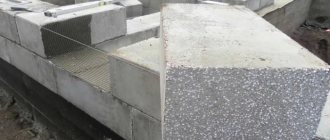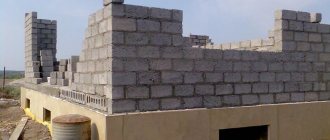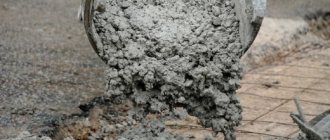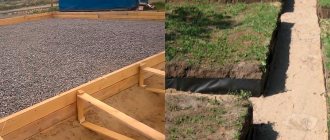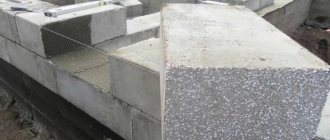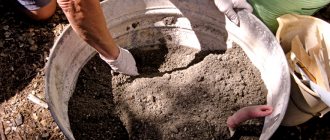Fortunately, the times when fastening any product or coating to concrete was a real problem are long gone.
Range of fastening elements
Instructions answering the question of how to hammer a nail into a concrete wall used to consist of actions such as:
- Drilling a hole in concrete, for which diamond drilling of holes in concrete was used;
- Hammering a wooden plug into this very hole;
- The fastening element was just being hammered or screwed into the plug.
Today, to produce such fasteners, specialized nails, dowels, and even liquid nails for concrete can be used.
Tools
This may seem strange, but the tools used to drive nails into concrete are exactly the same as when working with other materials.
Most often, a construction hammer is used, with a head weighing at least a kilogram and a fairly long handle. Using a lighter tool, you are unlikely to achieve success, because in our work we will need a large supply of energy, and a long handle will serve as an excellent lever. The easiest way to secure a nail in a concrete wall is to use a pneumatic, electric or powder nailer gun. By properly setting up the equipment, you can quickly complete a fairly large amount of work without much effort. Before using a powerful tool, be sure to read the user manual - not all nail driving devices allow you to work with concrete. If the manufacturer allows such use of its product, it is worth clarifying the necessary settings and requirements for fasteners in the passport.
Types of mounting guns and their purpose
Construction guns vary in different ways. When choosing a tool, you need to understand these features, then choosing the right option for the job will be easier.
It is important to consider the energy source, type of fastener and number of fasteners.
Energy source
There are four types of pistols based on the type of energy source. Each has its own advantages and disadvantages, so you should understand each type. There are: gas, pneumatic, powder and electric types.
Gas
The gas mounting gun is powerful and suitable for working with metal and concrete. To use it you need to have a gas cylinder available, its cost is high.
Expensive Prior is usually used by specialists; for domestic needs the cost is too high and is justified only after a long period of time.
Pneumatic mounting gun
The tool is an inexpensive option, but it requires a compressor with a receiver. Can cope with the installation of various fasteners to many materials. The exceptions are reinforced concrete, stone and thick types of metal.
Using a compressor, air is supplied to a special hose; when the button is pressed, the necessary pressure is applied and the fastener flies out of the compartment. The advantage is the practical noiselessness of operation, the disadvantages are:
- Inconvenience of work due to the hose;
- Requires access to electrical power.
Powder Nailer
It stands out for its special power and can be used for surfaces of any hardness. But its cost is high, and the fasteners for it are also expensive. The powerful force with which fasteners fly out requires special skills from the craftsman so that the work does not end in injury. Therefore, permission must be obtained to use it.
It is necessary to know and follow safety rules when working with a pistol.
Electric gun
The gun for electrical installation can be battery-powered or mains-powered. This tool is very expensive, so it is not available to everyone; it is advisable to purchase it only if you do installation work every day.
Can be used for various bases; the first type is characterized by mobility and lack of dependence on the power supply.
Type of fastener
Which fastening element can be installed using a gun must also be understood in advance. There are several popular options that are selected based on the type of foundation and the task at hand.
Nailer
Also called a nailer, it is quick to install. Selected for construction work or for working with furniture parts. It is distinguished by its ability to pierce hard materials, such as brick, then a reinforced type is selected.
Staple gun
A staple gun is similar to a staple gun. Only the staples in this case are distinguished by their large size.
Gun for dowel-nail
Dowel nails are often used by construction workers. Accordingly, a standard tool has been created that helps to install them quickly and effortlessly.
Number of fasteners
This parameter means how many nail cartridges can be nailed to the surface without the need to reload the tool. Accordingly, how much effort will have to be applied, and how quickly you can work.
Single shot
In this option, you will have to charge the pistol each time; a powder-powered tool will require charging and a cartridge. The installation pace will not be high, but compared to the manual option, the work will still proceed quickly.
Multi-charger
Such guns are provided with a special tape where it is necessary to install the accommodating number of fasteners. Recharging will be needed after all the nails are installed in the base.
Trigger method
The classic option is when the fastener is released after the trigger is pulled. There is a type when the mechanism is started by pressing the tip of the tool towards the surface.
The safest method is considered to be when both types of descent are combined.
Dowel nail
Needless to say, trying to hammer an ordinary nail into concrete is unlikely to be successful? To work with this dense building material, special nails made from special grades of steel are used. Also, nails for concrete, which are also called dowels, have a special shape - they are thicker than usual, have a massive head and, very often, a notch - longitudinal or spiral. Dowels for construction guns, produced in recent years, can also be equipped with a special ballistic tip, which facilitates the penetration of hardware into the thickness of dense material. Many types of dowel-nails are produced with a washer pressed onto the rod.
Depending on the shape of the working part, nails for driving into concrete and brick can be of the following varieties:
- Grooved - for the heaviest concrete;
- Flat – for fixing parts of small mass;
- Round is the most common classic type;
- Square - used when performing specialized work.
Hardened stainless steel is most often used as a material for dowel-nails, so corrosion is not a problem for such fasteners. Fastening using concrete nails is extremely durable, provided the installation technology is followed. A dowel hammered into a wall can perform its functions without reducing its load-bearing capacity for decades, even in the open air. It should also be mentioned that removing a nail, especially one hammered by mechanization, is a very difficult and time-consuming task. During dismantling, there are often cases of serious damage to the surface around the fastener, therefore, when choosing a place for the dowel, you need to be extremely careful.
Features of dowels for concrete and brick building structures
The dowels that manufacturers produce for concrete walls and other building structures made of similar material are not the same as fasteners for hollow bricks. To perform the required work efficiently, it is necessary not to confuse these two types of fasteners. Therefore, it is important to know their features.
On a note! It is irrational to use concrete fasteners in brickwork. Such an application is absolutely unjustified when the structure is made of blocks with voids. For masonry, special fasteners with a special device are used. In addition, its installation has certain nuances.
Thus, the design of fastening elements for brickwork with voids usually contains:
- Conical rim. It is necessary to control the installation depth of fasteners.
- Special tip. Thanks to its presence, the fastener twists when a screw is screwed into it.
- Locking wings that prevent the product from turning when screwing in hardware.
An example of dowels used in hollow masonry Source stroy-podskazka.ru
A concrete wall or other similar structure made of the same material is a solid element. Special fasteners are used for it. This is exactly what a concrete dowel is. Experts have been using this fastener for a long time. The classic option is the so-called dowel-nails.
The dowel itself is a spacer element. For concrete, manufacturers make it from different plastics, nylon material and even metal. Depending on the material used, dowels have certain parameters. It is the characteristics that influence the scope of application of spacer bushings.
Each dowel in concrete has a certain load-bearing capacity. Its value depends on the design, the so-called bushing, which has notches along its entire surface. It is thanks to them that the fastening element does not rotate in the hole and does not fall out of it even when exposed to the design load.
The design of the bushing also assumes the presence of elastic whiskers. They are always in a compressed position. This feature also affects the reliability of the fastening. In particular, the whiskers prevent the element from being pulled out of the recess.
Dowel with antennae for secure fastening in concrete Source leroymerlin.ru
On a note! The expansion of the sleeve occurs after screwing in, for example, a screw. Its unclamping is carried out due to the presence of slots in the longitudinal direction.
The fastener is fixed into the hole not only mechanically. Manufacturers also produce dowels that are specially designed for porous concrete. Their fixation is carried out with the additional use of special glue. First, a hole is made into the building structure. Then it is filled with adhesive. Then the fasteners are placed. Thanks to the glue, the fastening element is securely fixed in the cavity.
A dowel nail for concrete in a classic design is a universal product. Therefore, it is used in different fields. With the help of this fastener you can solve various important tasks. It allows:
- install different frames;
- fix furniture, paintings and other similar interior elements to structures;
- secure household technical devices.
Dowel-nail for fastening frames Source stroyka-hoz.ru
Today, builders and repair teams can use steel or aluminum nails for concrete for installation processes. This fastener is simply driven, for example, with a hammer into the created holes. It speeds up installation processes. Therefore, it is widely used during construction, repair, and finishing work.
Hammering a dowel nail into concrete
It is hardly worth stopping at driving nails using a mechanized method, since this work does not require any special tricks. But if you plan to fix the dowels manually, you need to know a few important nuances:
Carefully choose a place for the dowel-nail, since removing it from the concrete without “destruction” will be almost impossible.- Avoid cracks, chips and areas of concrete that have suffered from erosion - in such material the nail may not hold well, and if driven in there is a high probability of causing serious damage to the wall.
- Remove the washer from the nail by securing the fastener with pliers or a bench vise and applying several precise blows with a hammer.
- Hold the nail with pliers strictly perpendicular to the surface as tightly as possible.
- Use safety glasses or a face shield, as a dowel that bounces off during a strong impact can cause injury.
- Before hammering in a nail, you need to “punch” the attachment point.
- The dowel-nail is driven in with several strong, confident blows, and care must be taken that it enters the wall perpendicular to the surface.
Hammering dowels into concrete structures is a last resort, which is resorted to in the absence of alternatives. If possible, it is recommended to hammer nails with construction guns or use quick-installation dowels, as well as expansion and chemical anchors installed in holes prepared with a hammer drill.
Step-by-step instructions for special hardened nails
1) Before hammering a nail into a concrete wall, you need to check the quality and compliance of the product itself with standards: there should be no rust (remove), kinks (smooth with a hammer).
2) Make marks on the wall where the nail should be.
3) It is important to choose the right hammer (if you do not have a special nail gun): for a nail 4 centimeters long, a hammer weighing 250 grams will do, larger nails require a larger tool. To hammer nails longer than 8 centimeters, use a hammer weighing 1 kilogram. A universal option is a hammer weighing 500 grams.
4) Description of the process for right-handed people (for left-handed people it’s the same, only in reverse): the nail is taken in the left hand, the sharp end is pressed perpendicular to the base, the hammer is taken in the right hand. To hammer a nail into a concrete wall with a hammer without a drill, gently hit the head with the hammer, not very hard, so that the nail penetrates a quarter of the length into the wall. It is necessary to ensure that the movements of the hammer are carried out along a trajectory, the end of which becomes a continuation of the nail. Otherwise, curved impacts will cause damage to the nail, material and injuries.
5) Next, you need to continue to apply strong, confident blows to the head of the rod until it sinks into the material to the desired length.
Using a special gun is of course easier to do this, but it is not cheap at all and is more suitable for professionals:
How to make a hole in the wall using available materials
Interior decoration with paintings
When starting a renovation or wanting to decorate a room with a decorative element, you may encounter typical difficulties.
If the wall where the desired picture or shelf will be hung is concrete, you must use a drill or hammer drill.
But not every person has expensive tools. Therefore, you should not abandon the planned solution, just think about possible cheaper analogues.
First, you need to decide on the size of the desired hole and the object that will replace the hammer drill. If the diameter does not exceed 10-15 mm, a bolt is ideal. This is the name of a metal tube with sharpened teeth at the end.
The bolt is placed on the intended area and hit with a hammer. After each pair of blows, turn it a third of a turn and continue further, not forgetting to periodically shake out the accumulated dust in the hole.
If you don't have a bolt, you can use:
- steel rod
- punch
- metal drill
The selected item must be modified in advance. The end on which we will hit with a hammer should be sanded with sandpaper to give a smooth surface so that it is convenient to hit. The other side must be sharpened, and then used in the same way as a bolt.
If you encounter a hard stone in your work, you can take a special dowel-nail. After removing the washer and holding it with pliers, pointing it slightly upward, apply careful blows. The sharp thin tip will split the stone, after which the main tool will finish it.
Taking care of the aesthetic appearance, it is important to do everything carefully, having previously marked the point of contact of the wall with the bolt, that is, the future hole, with a pencil. Next, carefully, without jerking and keeping an eye on the point, a hole is made. The end result should not have any breaks, so it is important to pay due attention to the process.
In this simple way you can hammer a nail into a concrete wall without a hammer drill.
What can replace a nail?
Dowel instead of nail
When it comes to concrete, a nail is considered a poor solution.
You can replace it with a dowel.
It is sold in construction stores and is relatively inexpensive.
The buyer has a wide selection of products to choose from: plastic, metal, nylon.
If you need to hang a picture or a shelf, when hammering it in, you need to hold it at an angle from top to bottom.
Thus, the mount will become more reliable and will last for many years. In case of unexpected impact on the walls due to time or climate conditions, the interior part will not fall and will hold securely.
Special dowel-nails would also be an ideal option. They are designed to be driven directly into concrete. Concrete nails have thicker walls, so they won't break while working with them.
The material and design make them easy to use, just use a heavy hammer for greater efficiency. They will fit perfectly into the wall.
If it is possible to replace the nail with a more suitable solution, you should pay special attention to this.
Features of working with dowels
Fasteners are selected taking into account the depth of drilling or anchoring, and it, in turn, depends on the material of the walls. Concrete structures must be drilled to a depth of 45 mm, and there must be at least 30 mm between adjacent dowels. Holes in walls made of white sand-lime brick should have a depth of 55 mm. Anchoring is performed in increments of 40 mm (or more).
A wall or partition made of pumice is first drilled with a drill to a depth of 65 mm. The screws are placed at a distance of at least 50 mm from each other. If the wall consists of cellular concrete, a distance of 60 mm should be left between adjacent screws. The depth of the hole in this case will be 75 mm.
A wall made of red solid brick is drilled to a depth of 55 mm. Hardware is placed at a distance of 40 mm or more.
Drive a nail using a cork
Wooden plugs - chopiki
In cases where replacing a nail is not permissible, they resort to using a wooden plug, called by many a chopik.
It is cut out of wood and adjusted to the required dimensions.
The length corresponds to the depth of the hole; one tip is made in the shape of a cone for better fit.
The width of the other edge is left 2-3 mm larger than the hole. If you don’t want or have the opportunity to make a chop yourself, you can buy it in a store by choosing the appropriate size.
You can make a cut in the sharp tip of the chopik and insert a small wedge. By reaching the bottom of the hole, it will increase the strength of the connection between the chop and the wall.
So, hammering a nail into a concrete wall without a drill will be much easier. The soft, wooden surface of the chopik will replace the hard material of the wall. You just need to carefully, slowly hammer in the nail and you're done.
You can easily screw a self-tapping screw or screw into a clogged recess. This can be made more convenient with the help of special plastic plugs, which are sold in stores. Then, you don’t have to take the chopik into account. By inserting the dowel into the recess made by the skewer, the self-tapping screw is easily screwed in.
The use of wooden plugs is also not necessary. It is enough to fill the hole with a solution consisting of cement or alabaster, then insert a screw, the screws of which are pre-wrapped with wire and blotted with a raster.
A hole in the wall without drilling, dust and dirt - on video:
Related article: Mesh for sanding walls
Noticed a mistake? Select it and press Ctrl+Enter to let us know.
Where is it used?
Using a gun for driving dowels, nails, pins and other fasteners greatly simplifies and speeds up the installation process. Drive fasteners into different types of surfaces:
- concrete;
- brick;
- plastic;
- stone;
- tree.
It is rational to use a nail gun for large volumes of installation work of the same type. This tool is used for the following work:
- when carrying out communications , a quick fixation is created here, which guarantees the accuracy of the laying;
- for fastening the facing material to the wall - a large number of components are quickly and efficiently attached using special nails in a relatively short period of time;
- when fixing the roof , the work process is significantly accelerated and, thanks to the existing adjustment system, the fastening parts are driven in at the desired angle.
The main advantage of installation using a nail gun is that the integrity of the working surface is not compromised, and chips and deformations do not occur. Even when attached to thin structures, the clamps do not distort them.
How to hammer dowels into a wall
- 1 Type of dowels
- 2 The process of hammering the dowel
- 3 Videos
When performing many repairs, it is often necessary to use dowels. When this part is driven into the wall surface, a reliable fastening unit is created that can withstand heavy loads. A correctly driven dowel is almost impossible to remove from the body of material in which it is fixed. Let's figure out how to drive dowels into a wall correctly.
Tips for choosing
A construction gun should be considered as a convenient tool for driving dowels.
Its use allows you to significantly speed up the installation process. The use of this tool ensures reliable fixation of the necessary fasteners. However, it should be understood that depending on the type of installation tool chosen, the range of actions that it is able to perform is limited. Thus, electric guns, which have low power, can make it easier to carry out work at home. Gas and powder devices, due to the fact that gas is released when they are used, can only be used outdoors. The most multifunctional version of such a tool are pneumatic models.
Type of dowels
There are many types of dowels. For each specific case, different ones are selected - it all depends on the task at hand. All dowels are divided into two large groups: universal and spacer.
Expansion
Expansion dowels include fasteners whose body undergoes expansion during installation. The top part of the part is usually made of dense plastic, while the core, which is screwed into the sleeve, is made of plastic or metal. Such dowels are mainly driven into solid walls with solid filler.
Universal
Universal dowels can be fixed in a wall that is hollow. The material of the upper part of such a dowel, under the influence of the rotating force of the core, twists and forms a nylon surface that fits tightly to the surface of the hole made in the wall. To fix insulation, dowels with wide heads are used.
Disc-shaped
The length of the dowels varies widely - from 20 to 120 mm. The same applies to the diameter of parts – from 4 to 20 mm.
One of the most popular fasteners are plastic expansion dowels. The body in such parts is made of nylon, polypropylene or other identical materials. The sleeve of such a dowel looks figurative - many sharp protrusions and tendrils are visible on it, thanks to which the part “sits” firmly in the wall. The plastic expansion dowel is equipped with a metal core that is longer than the outer base. The core is threaded or has cone-shaped formations. Thanks to them, the inner part of the dowel, when screwed in, is firmly held in the plastic sleeve and, accordingly, in the wall.
Peculiarities
Self-tapping screws for concrete allow you to make holes in the material without pre-drilling . Outwardly, they look like ordinary screws. Such products are made from hard and especially durable steel.
Hardened types of steel give fasteners high strength. Together with additional protective coating, they become extremely hard, wear-resistant and reliable fasteners.
Such self-tapping screws have non-standard threads. Its structure changes along the length of the tool, which ensures the most reliable fixation of the device in concrete.
The head of these products is often made like an asterisk or a cross. These options are considered the most convenient, because during the screwing process significant physical effort has to be applied, and conventional splines often cannot withstand the load and fly off. But there are also models made with a hexagon.
Self-tapping screws for concrete without drilling are made with the most pointed tip, which easily fits into a dense concrete structure . The devices provide for the possibility of reuse.
As a rule, the tip has a cone shape. This makes it possible to easily screw the tool into porous concrete surfaces without pre-drilling.
Such self-tapping screws are most often used when carrying out various finishing works, assembling furniture and other interior items. But it is important to choose a tool in accordance with the type of structure that needs to be fixed.
The process of driving a dowel
During construction and repair, the dowel with a self-tapping screw or dowel-nail is most in demand; they can be fastened in different materials. In order to properly fix them in the wall, ensuring high-quality fastening, certain conditions must be observed. Only at first glance it seems that driving dowels into the wall is very simple. In order not to damage the material, you must follow the rule that the dowel body should not protrude beyond the edge of the wall surface.
A hole is being drilled
- A hole is made in the wall with a hammer drill, and the diameter of the drill must match the cross-sectional size of the dowel sleeve. It is important that the depth of the hole is 0.5 cm greater than the length of the dowel.
- After the hole is made, it must be cleaned with a long object at hand. To get rid of dust, the hole can be blown out with air or, for example, cleaned with a vacuum cleaner.
- Then you need to insert the dowel body into the hole and hammer it in until the edge of the part coincides with the surface of the wall.
- After this, the self-tapping screw is screwed into the plastic base almost all the way. In the version with a nail, the latter is driven in with a hammer. The core, after entering the body of the outer shell of the part, will have a bursting effect on the base in the hole, and it will be almost impossible to pull out the dowel. To install the dowel efficiently, you need to follow all the necessary rules.
Dowel in hole
It is necessary to take into account that the core needs to be twisted, and not driven in with a hammer. Otherwise, the bushing may rupture and lose its fastening properties. This statement is only suitable for dowels whose core is a self-tapping screw. The nail must be driven in with a hammer until it stops.
Powder pistol device
If we do not take into account some technical nuances of the design (and this type of construction tool is produced both in our country and abroad), then a single-shot powder mounting gun consists of:
- Replaceable barrels with different lengths and diameters of the guide part.
- The chamber where the mounting cartridge is located.
- Coupling coupling.
- The housing where the firing mechanism is located.
- Handles.
In turn, the piston part includes the guide itself, a divider and a shock absorber. All this is connected to the handle of the tool through a hinge.
To zero, the barrel is placed perpendicular to the dowel direction axis, the hammer trigger is pulled all the way, and the handle is pressed. In this case, the guide, overcoming the resistance of the divider and shock absorbers, presses its sharp end onto the surface of the mounting cartridge capsule. The primer is pierced and the gunpowder is ignited. The resulting powder gases accelerate the piston, which strikes the head of the dowel-nail.
Depending on the standard size of the installed barrel, the speed of movement of the piston increases parabolically on the guide section with a length of 25 to 35 mm. Next, the dowel, which reserves sufficient kinetic energy, moves by inertial forces. Since the resistance of the material simultaneously increases, the movement of the dowel gradually slows down and it stops at a certain depth.
Sometimes, when adjusting fasteners to a softer material, its resistance is not enough to stop the dowel. In this case, excess powder gases pass through the divider, enter the coupling, from where it is squeezed out into the atmosphere.
If the dowel-nail rod is completely in the main surface, then the mechanical braking of the piston is triggered: the elastic petals of the shock absorbers bend and stop its movement. This prevents the fastener head from being crushed.
Since zeroing is accompanied by a loud and sharp sound, the installer must wear noise-cancelling headphones.
How to hammer a nail into a concrete wall without a hammer
Nails for aerated concrete or concrete differ significantly from products intended for fastening other bases. In order not to make a mistake when installing them, it is worth learning a little more about these rod elements.
Types of fasteners for concrete
Trying to hammer in an ordinary construction nail, it becomes obvious: the idea is bad - it does not go into the wall, but only bends. Classic wire hardware is made of low-carbon steel, which is characterized by low strength. In the case of elements intended to be embedded in concrete, the material used is distinctively different. Only high-carbon metal that has undergone heat treatment, that is, hardening, is used.
Related article: Minimum thickness of a monolithic wall
The fact that the nails are made of stainless hardened steel makes it unnecessary to cover them with a protective layer. However, in some situations it is important to use additional thickness.
- traditional (simply hardened) – applicable for any external/internal work, with the exception of structures with excessively high humidity;
- galvanized (minimum zinc layer 5-6 microns) – used in damp rooms and production facilities;
- brass - have an aesthetic golden hue, the highest resistance to moisture and acids, they should be installed in places where exceptional anti-corrosion is required (for example, in shipbuilding).
The shape of the rod can be:
- flat – suitable for holding lightweight structures;
- round – standard option, capable of withstanding high loads;
- square - in terms of functional qualities they are not inferior to “cylinder nails”, but have a different cross-section;
- grooved - used when it comes to particularly dense material - heavy concrete.
Speaking about parameters such as weight, length, diameter, the range here is incredibly wide. Why is there no single standard size? For various designs, it is necessary to select elements of suitable sizes.
The classification according to the material from which the dowel is made deserves special attention. This spacer provides secure fastening of the nail and is usually made from:
- plastics (polyamide, polyethylene, polypropylene);
- metal
In the first case, it is a hollow cylindrical rod that expands from the middle during installation. The top is specially equipped with a cuff to avoid falling into the drilled hole. Fasteners of this type have threads on the surface, and their heads are characterized by the presence of a slot - a recess in the head. All this makes installation easy, even with the use of a screwdriver. You will find more recommendations on choosing dowels for a gas block in this article.
Unlike fasteners with plastic dowels, metal ones have a rod with a smooth surface, without threads. Expansion occurs when driven into the wall. The reverse process - dismantling - is quite complicated, so it requires long-term operation. They are important to use when working with very hard, solid materials.
A type of metal fasteners are those that require fixation using a pneumatic gun. Their base is a thick rod pointed at the end with an enlarged cap that prevents it from falling through. A lock washer is included in the package. Installation with a pneumatic gun is the fastest, least labor-intensive process necessary to create structures of the highest strength. However, such elements are not intended to be reposted.
Top 10 mounting guns for concrete
Concrete mounting guns are a faithful assistant to a professional builder with a wide range of capabilities. They are designed for driving dowels, and can even work on metal, brick, cinder block, etc. In the case of a mounting gun, you only need to accurately set the profile and pull the trigger - this takes a matter of seconds. And just imagine how the installation process speeds up when it comes to large volumes of work. But how to choose a good concrete mounting gun? In this article we have collected information about the ten most popular and best models of this device.
Photo: beton-house.com
